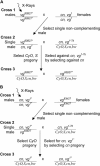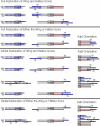Transvection at the vestigial locus of Drosophila melanogaster
- PMID: 15944352
- PMCID: PMC1449749
- DOI: 10.1534/genetics.105.041400
Transvection at the vestigial locus of Drosophila melanogaster
Abstract
Transvection is a phenomenon wherein gene expression is effected by the interaction of alleles in trans and often results in partial complementation between mutant alleles. Transvection is dependent upon somatic pairing between homologous chromosome regions and is a form of interallelic complementation that does not occur at the polypeptide level. In this study we demonstrated that transvection could occur at the vestigial (vg) locus by revealing that partial complementation between two vg mutant alleles could be disrupted by changing the genomic location of the alleles through chromosome rearrangement. If chromosome rearrangements affect transvection by disrupting somatic pairing, then combining chromosome rearrangements that restore somatic pairing should restore transvection. We were able to restore partial complementation in numerous rearrangement trans-heterozygotes, thus providing substantial evidence that the observed complementation at vg results from a transvection effect. Cytological analyses revealed this transvection effect to have a large proximal critical region, a feature common to other transvection effects. In the Drosophila interphase nucleus, paired chromosome arms are separated into distinct, nonoverlapping domains. We propose that if the relative position of each arm in the nucleus is determined by the centromere as a relic of chromosome positions after the last mitotic division, then a locus will be displaced to a different territory of the interphase nucleus relative to its nonrearranged homolog by any rearrangement that links that locus to a different centromere. This physical displacement in the nucleus hinders transvection by disrupting the somatic pairing of homologous chromosomes and gives rise to proximal critical regions.
Figures





Similar articles
-
Effects of chromosomal rearrangements on transvection at the yellow gene of Drosophila melanogaster.Genetics. 2009 Oct;183(2):483-96. doi: 10.1534/genetics.109.106559. Epub 2009 Aug 10. Genetics. 2009. PMID: 19667134 Free PMC article.
-
The effects of chromosomal rearrangements on the zeste-white interaction in Drosophila melanogaster.Genetics. 1987 Jun;116(2):285-98. doi: 10.1093/genetics/116.2.285. Genetics. 1987. PMID: 3111938 Free PMC article.
-
Homologous association of the Bithorax-Complex during embryogenesis: consequences for transvection in Drosophila melanogaster.Development. 1998 Nov;125(22):4541-52. doi: 10.1242/dev.125.22.4541. Development. 1998. PMID: 9778512
-
Transvection in Drosophila.Adv Genet. 2002;46:399-420. doi: 10.1016/s0065-2660(02)46014-2. Adv Genet. 2002. PMID: 11931232 Review.
-
The power of proximity: mechanisms and biological roles of transvection.Curr Opin Genet Dev. 2024 Dec;89:102269. doi: 10.1016/j.gde.2024.102269. Epub 2024 Oct 4. Curr Opin Genet Dev. 2024. PMID: 39368316 Review.
Cited by
-
Enhancer blocking and transvection at the Drosophila apterous locus.Genetics. 2008 Jan;178(1):127-43. doi: 10.1534/genetics.107.077768. Genetics. 2008. PMID: 18202363 Free PMC article.
-
Random homologous pairing and incomplete sister chromatid alignment are common in angiosperm interphase nuclei.Mol Genet Genomics. 2007 Aug;278(2):167-76. doi: 10.1007/s00438-007-0242-0. Epub 2007 May 24. Mol Genet Genomics. 2007. PMID: 17522894
-
Enhancer-promoter communication at the yellow gene of Drosophila melanogaster: diverse promoters participate in and regulate trans interactions.Genetics. 2006 Dec;174(4):1867-80. doi: 10.1534/genetics.106.064121. Epub 2006 Oct 22. Genetics. 2006. PMID: 17057235 Free PMC article.
-
The Capacity to Act in Trans Varies Among Drosophila Enhancers.Genetics. 2016 May;203(1):203-18. doi: 10.1534/genetics.115.185645. Epub 2016 Mar 16. Genetics. 2016. PMID: 26984057 Free PMC article.
-
Interphase chromatin organisation in Arabidopsis nuclei: constraints versus randomness.Chromosoma. 2012 Aug;121(4):369-87. doi: 10.1007/s00412-012-0367-8. Epub 2012 Apr 4. Chromosoma. 2012. PMID: 22476443
References
-
- Ashburner, M., 1989 Drosophila: A Laboratory Handbook, pp. 550–554. Cold Spring Harbor Laboratory Press, Cold Spring Harbor, NY.
Publication types
MeSH terms
Substances
LinkOut - more resources
Full Text Sources
Molecular Biology Databases

